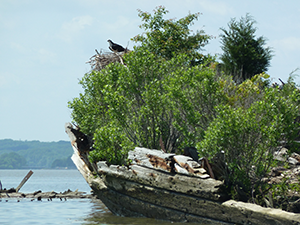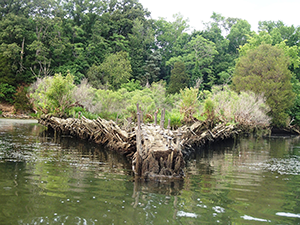 Situated 30 miles from Washington D.C. along the Lower Potomac River off the Nanjemoy Peninsula of Charles County,
Maryland, Mallows Bay may be considered one of the most exceptional time
capsules of American maritime history in one discrete location in the
nation. This area is also home to a diverse ecosystem whose synergy with
the shipwrecks attracts recreational fishing and the beginnings of an
ecotourism industry. Charles County and the State of Maryland continue
to work to expand access to this area, while protecting the assets and
promoting sustainable ecotourism.
Situated 30 miles from Washington D.C. along the Lower Potomac River off the Nanjemoy Peninsula of Charles County,
Maryland, Mallows Bay may be considered one of the most exceptional time
capsules of American maritime history in one discrete location in the
nation. This area is also home to a diverse ecosystem whose synergy with
the shipwrecks attracts recreational fishing and the beginnings of an
ecotourism industry. Charles County and the State of Maryland continue
to work to expand access to this area, while protecting the assets and
promoting sustainable ecotourism.
This shallow embayment and the
waters immediately adjacent are home to nearly 200 historic shipwrecks
dating from the Revolutionary War through the present, known as the
“Ghost Fleet” of Mallows Bay.
 On April 2, 1917, President Woodrow Wilson issued a national call to arms against Imperial Germany. What followed in the United States was a frenzied effort to build 1,000 wooden merchant ships in 18 months, as part of the greatest shipbuilding campaign in history, to replace those of America’s allies being destroyed in Germany’s campaign of unrestricted submarine warfare. Under the newly created U.S. Shipping Board, the Emergency Fleet Corporation embarked on a course that, in the span of the following pivotal years of American history, came to exhibit mankind’s genius, ignorance, avarice, and drive. In the process, the United States emerged as the greatest shipbuilding nation in world history.
On April 2, 1917, President Woodrow Wilson issued a national call to arms against Imperial Germany. What followed in the United States was a frenzied effort to build 1,000 wooden merchant ships in 18 months, as part of the greatest shipbuilding campaign in history, to replace those of America’s allies being destroyed in Germany’s campaign of unrestricted submarine warfare. Under the newly created U.S. Shipping Board, the Emergency Fleet Corporation embarked on a course that, in the span of the following pivotal years of American history, came to exhibit mankind’s genius, ignorance, avarice, and drive. In the process, the United States emerged as the greatest shipbuilding nation in world history.
Today, the largest extant remnants of that fleet, over 130 wooden and composite steamships built during and immediately after the war, representing the product of dozens of shipyards across the nation, still rests on the shallow floor of the Potomac River at and near Mallows Bay.
 In Mallows Bay, theses World War I-era vessels, as well as scores of others dating from the American Revolution onward, including extinct indigenous Chesapeake Tidewater sailing craft as well as other vessel types from many states, represents one of the most extraordinary maritime archaeological environments in the world. Also contained within this region are the physical remnants of one of the
most unique industrial ship-breaking undertakings in American history,
and nineteenth century commercial fisheries operations, as well as
Native-American, colonial, and Civil War terrestrial sites.
In Mallows Bay, theses World War I-era vessels, as well as scores of others dating from the American Revolution onward, including extinct indigenous Chesapeake Tidewater sailing craft as well as other vessel types from many states, represents one of the most extraordinary maritime archaeological environments in the world. Also contained within this region are the physical remnants of one of the
most unique industrial ship-breaking undertakings in American history,
and nineteenth century commercial fisheries operations, as well as
Native-American, colonial, and Civil War terrestrial sites.
Due to the area’s historical significance, the Mallows Bay – Widewater
Historic and Archeological District was listed on the National Park
Service's National Register of Historic Places in April 2015.  Click here to view the full NRHP application.
Click here to view the full NRHP application.
Acknowledgements: Photos courtesy of Darryl Byrd, Maryland Public Television, Kimberly Hernandez and Stephen Badger.